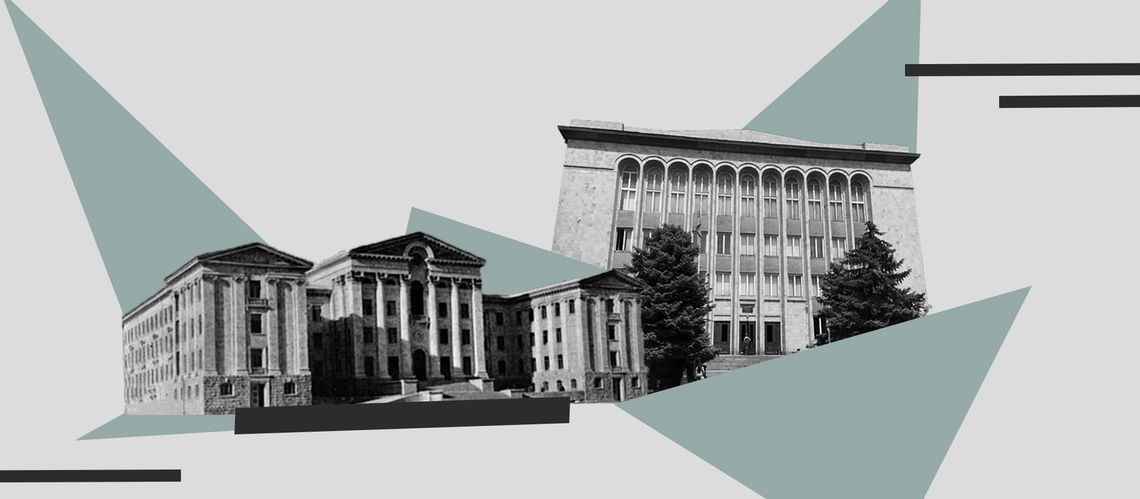
Expressing the collective will and tacit frustration of the Armenian electorate over the pace of judicial and structural reforms, the National Assembly, during a special session on June 22, 2020, initiated and unanimously approved a set of Constitutional amendments.[1] A tactical coup de grâce by the majority My Step faction, this procedural mechanism entailed a strategic utilization of parliamentary rules designed to uproot the entrenched problems of the Constitutional Court which, for the most part, is a remnant of the previous, undemocratic regime. This legal and tactical maneuvering remains remarkably consistent with the recommendations of the Venice Commission as well as the judicial reforms package that the Government proposed and Parliament approved earlier in the year. Within the scope of political developments, the parliamentary majority qualified this move as an expression of popular will, considering My Step’s supermajority in Parliament. This qualification was further superseded by the broad public support for such an initiative, considering consistent concerns of legitimacy that Armenia’s judicial system, and by extension the Constitutional Court, has suffered from since the Velvet Revolution. Eighty-two percent of Armenian society consider judicial reforms as a top priority. Thus, in one broad stroke, Armenia’s Parliament conciliated the demands of the Armenian public, while at the same time resolving an inter-institutional crisis between the branches of government that had been simmering for the last two years. Needless to say, the strategic acuteness and alacrity of these developments caught proponents of the previous regime, as well as oppositional factions, off-guard.
Crisis of the Constitutional Court
The Constitutional Court, immediately after the Velvet Revolution, suffered from two types of crises: first, a crisis of political legitimacy, and second, a crisis of institutional legitimacy. In the case of the first, the Court was packed with operatives of the previous regimes, who had for years justified and utilized the highest court in the country to prop-up the extralegal and undemocratic behavior of the political elite. Armenian society had absolutely no faith in this institution or its judges. The second crisis was more nuanced, as the previous regime had utilized a concept that political scientists call “institutional insulation,” where the constitutional arrangements and institutional structure is designed in a fashion that insulates the interests of the regime within that institution and guarantees its longevity even in the case of future political upheavals.
This process of institutional insulation was spearheaded by Hrayr Tovmasyan, who served as Minister of Justice under the previous Sargsyan Administration, was the architect of the 2015 Constitution amendments, and who assumed the Chairmanship of the Constitutional Court under the very laws that he himself wrote. In quite simple terms, Tovmasyan, in conjunction with then-President Sargsyan and their Republican Party, rigged the constitutional and institutional arrangements of the Constitutional Court to insulate it from any future alterations. This capacity for insulation, of course, guaranteed an entrenched infrastructure that would continue to serve the interests of that regime and its lackeys: a branch of Armenia’s government was institutionally co-opted.
How did Tovmasyan design this institutional insulation? By “grandfathering” the terms of tenure from the previous Constitution, inserting himself into the “grandfathered” or “transitional” clause, and then installing himself as Chairman of the Court. According to the 1995 Constitution, under Article 96, a judge’s tenure in the Constitutional Court was until the age of seventy. With the modified 2005 Constitution, under the amended Article 96, the tenure of a judge was reduced to sixty-five years of age. When designing the 2015 Constitution, Tovmasyan included a new alteration: under Chapter 7 Article 166(1), tenure of a judge was no longer defined by age, but rather a fixed term limit of 12 years. Thus, Constitutional Court judges, according to the 2015 Constitution, will serve a maximum term of 12 years. So far so good, until Tovmasyan inserted Article 213 to secure institutional insulation: the so-called transitional clause. The 12 year tenure will apply only to judges who are appointed after 2018 (when 2015 Constitution goes into effect) and as such, judges who are serving under the 1995 Constitution will stay in office until age of 70 and judges serving under the 2005 Constitution will serve until the age of 65. And to put the icing on the cake, Tovmasyan is appointed to the Constitutional Court and assumes its Chairmanship three weeks before the 2015 Constitution goes into effect, thus “grandfathering” himself under the 2005 Constitution. As such, he will not serve under the 12 year cap, but rather, will serve until the age of 65. In its report, the Venice Commission concedes that this was inherently problematic and even notes that it was “contrary to the spirit” of the 2015 Constitution.[2] Thus, between Tovmasyan’s Chairmanship, guaranteed tenure, and the large majority of Constitutional Court judges also “transitioned” or “grandfathered” in,[3] the institutional insulation of the Constitutional Court was complete. Needless to say, this blatant mockery of institutional manipulation enraged both civic society and democratic activists. And upon the maturation of the Velvet Revolution, an institutional and constitutional crisis ensued: New Armenia had to find the legal means to dislodge an insulated, “illegitimate” Constitutional Court.
Resolving the Constitutional Court’s Crisis of Legitimacy
The Government’s proposal to this constitutional crisis was a referendum, where Armenian society would vote to either support or deny an amendment to the Constitution that would remove 7 of the 9 judges (7 had been “transitioned,” while the other 2 appointed after 2018).[4] The developments with Covid-19 shelved the referendum, and the continued state of emergency, along with an unpredictable continuation of the pandemic, stagnated the process.[5] The new solution, as allowed by the Constitution under Article 202.2, was to implement the amendment process through the National Assembly.
The new amendments that were now proposed, however, were quite different than what was initially proposed under the referendum.[6] In compliance with the recommendations proposed by the Venice Commission,[7] the Government refrained from proposing the removal of the 7 judges (i.e. the ceasing of Article 213), but rather, selected to amend Article 213 under which the 12 year fixed-term would apply consistently and uniformly to all Constitutional Court judges.[8] As such, the ad hoc and arbitrary “grandfathering” that Tovmasyan has instituted would be negated: all judges who have served 12 years or more would retire, while those that have not met the 12 year tenure will continue until they do. The Venice Commission qualified these objectives as “a legitimate aim” and agreed that these are “good arguments in favor of the new approach proposed by the Armenian authorities.”
While amending Article 213 was not legally controversial, the issue of judicial review by the Constitutional Court—for all proposed amendments to the Constitution—became robustly contested. The Bright Armenia Party, for example, made a spirited argument that the proposed amendments to the Constitution must first be reviewed by the Constitutional Court, as specified under Articles 168(2) and 169(2). If the Court declares the proposed amendments unconstitutional, then they must be retracted. The My Step faction, however, argued that asking the Constitutional Court to review a matter that directly involves the Constitutional Court is a conflict of interest, and per Article 14(2) of the Law on the Constitutional Court of Armenia, judges must recuse themselves from such cases. As such, the tenability of a blanket judicial review principle is not applicable. The letter of the law and the spirit of law appeared in a state of contradiction. The outcome of this debate, in essence, was a fascinating legal impasse, as both sides made legally-consistent claims.
The determination of the Venice Commission, however, supported the Government’s (My Step’s) position, but the legal basis was more nuanced. While Bright Armenia is consistent in its general application of Articles 168(2) and 169(2), the precept of judicial review, however, does not apply to all forms of proposed amendments. Per Armenia’s Constitution, there are two types of amendments: “amendable” and “unamendable.” Proposed amendments that are “unamendable” must be submitted to the Constitutional Court for judicial review, while proposals that are “amendable” need not be submitted for judicial review. Article 203 of the Constitution specifies that only Articles 1,2,3 and 203 are “unamendable,” and as such, the amendment of any other Article does not require judicial review. In this case, since the matter pertains to Article 213, which clearly is “amendable,” judicial review by the Constitutional Court is not required.[9]
In its totality, between the legal and constitutional soundness of the Government’s proposed amendments, and the Venice Commission’s agreement with the legal, theoretical, and conceptual foundations of the proposed amendments, the Armenian Government has established itself on solid legal grounds, both in compliance with domestic[10] as well as international legal standards. Consistent with these precepts and stipulations, the National Assembly voted 89-0 to pass the proposed Constitutional amendments, thus altering Article 213 without the necessity of judicial review. Based on this development, three of the current judges, each having surpassed one’s collective 12 year tenure, must immediately retire, paving the way for the nomination and confirmation of three new judges to the Constitutional Court.[11] Implicit in these developments is also the removal of Hrayr Tovmasyan from the Chairmanship. Namely, while he will continue to serve on the Court until his 12 years are up, he will no longer serve as Chairman, for a new one will be elected by the Constitutional Court itself upon the confirmation of the three new judges.
Oblivious to the interpretative consistency on the Constitutional Court’s limitations on judicial review, Tovmasyan, along with the two judges that will be forced to retire due to this amendment (Alvina Gyulumian and Felix Tokhian),[12] have pushed back against the Constitutional amendment. Their argument appears to be aligned with the position of anti-government forces who are seeking to secure the “insulation” of the Constitutional Court. They are fervently attempting to utilize every constructed safeguard to guarantee the entrenchment of institutional insulation. Thus, they are stipulating the power of blanket judicial review of all amendments, regardless of whether it is “amendable” or “unamendable,” hence contradicting and disregarding the guidelines and recommendations of the Venice Commission. Needless to say, the recommendations of the Venice Commission are not absolute; they are primarily advisory. However, considering the accepted axiom in recent Armenian jurisprudence that the opinions of the Venice Commission qualify as the golden standard in interpreting the Constitution, an axiom that this Court, itself, has relied on as precedent, the posture of Tovmasyan and the two other judges is quite unbecoming.
Agreeing to Disagree
The Venice Commission’s report concedes that ultimate authority lies in the democratic will of the Armenian people, which is expressed and represented in its National Assembly. The Venice Commission also goes into painstaking detail to address the importance of the independence of the judiciary, and commends the Armenian political system for having important safeguards. And between these two principles, the Commission makes a very important point: a simple parliamentary majority cannot superimpose itself upon judicial independence. It is in this context that Armenia’s process is extolled: Constitutional changes are not implemented through simple majority, but rather through a 3/5 constitutional majority. This exceedingly high threshold reconciles the two principles: the will of the people and the elevated criteria for Constitutional change. This premise, then, negates the unfounded claims of anti-government forces who argue that what is transpiring in Armenia’s legal realm is the tyranny of the majority. A constitutional majority is not the same as a simple majority; constitutional majority is the epitome of the will of the people expressed in a system of democracy.
The alignment of the Government’s proposals and the Venice Commission’s recommendations on all matters constitutional is unequivocal. The Commission’s report confirms the legality and constitutionality of the amendments to the Constitution. This incontrovertible affirmation of constitutional legitimacy, however, is separate from the Commission’s recommendations on subsequent procedures. Namely, the Commission provides recommendations on post-hoc developments, but these have nothing to do with the legal or constitutional processes. Rather, these recommendations are left at the discretion of the Government, since they are procedural. One such procedural recommendation that the Venice Commission made to the Armenian Government was to allow a “transitional period” through which judges who are to retire based on the new amendments would do so gradually.[13] This gradual “transitional measure” is also being recommended for the change in the Chairmanship, for the Commission recommends against undertaking abrupt changes.
These recommendations by the Commission, however, are both vague and discretionary (unlike the stimulative recommendations regarding the Constitutional Articles and judicial review). Further, the Commission concedes that the Government’s concerns with a prolonged transition period are correct, for such would contradict the spirit of the Constitutional reforms.[14] Recognizing the discretionary nature of its recommendation, the Commission notes that “the authorities are best placed to measure the length of this transitional period and the Commission is not in a position to propose a concrete time period.”[15] Addressing the “transitional period” measure, the Government has specified the nature and scope of the amendments, demonstrating that for judges that have already surpassed their 12 year tenure, a transitional period on top of their excessive tenure would arbitrarily negate the fairness doctrine. Namely, it will allow a formal violation of the 12 year fixed-term stipulation. While the Commission “regrets” that the “transitional measures” were not tabled, it nonetheless understands and concedes the discretionary nature of its recommendation. In this context, the agreement on Constitutional legality is absolute, while procedures for post-hoc processes rely on discretionary qualifications for a transition period.
The Politics of Resolving the Constitutional Crisis
Considering how the recommendations of the Venice Commission were consistent and legally aligned with the Armenian Government’s proposals, this legitimized the legal consistency of amending the Constitution through the National Assembly. At the same time, this also provided the foundations to negate the dubious legal arguments of anti-government forces (comprised mostly of extra-parliamentary actors). Lacking the substantive basis to counter the legal consistency of the Government’s approach, these forces have resorted to three observable patterns of behavior.
The first revolves around operatives of the previous regime who are frustrated by the current Government’s ability to dislodge the entrenched structural interests that these actors had embedded in Tovmasyan’s Constitutional Court. Unable to reconcile their inability to deconstruct the Government’s legal argument, these actors have resorted to an astonishing line of reasoning: attacking the Venice Commission and accusing it of politicization. The absurdity of such an argumentation, of course, defies logic, for they are accusing the Council of Europe’s advisory body of violating its ethical and legal obligations to over 29 states just to appease the Government of Armenia. This modality of irrational politicking, more than anything, demonstrates an embrace of the nonsensical. Struggling to construct a tenable narrative, these operatives, which include such figures as former Ministers of Justice Davit Harutunyan and Arpine Hovannisyan, have essentially relied on empty rhetoric.
The second set of detractors are not so much anti-government forces as they are a loose collection of online commentators, social media pundits, pseudo-analysts, and armchair activists. The lamentations of this group do not revolve around legal or constitutional nuances, but rather, as very simplified, intellectually-lazy set of recriminations against the Pashinyan Government. Relying mostly on recycled commentary, these critics contend that the Constitutional amendments are reactionary, spur-of-the-moment temper tantrums driven by the Prime Minister’s visceral need for political vendetta. Lacking in-depth and nuanced understanding of political developments in Armenia, their arguments border the juvenile. Institutional reforms, for example, are conflated as orchestrated acts of political revenge by the Prime MInister’s Office, failing to understand that these programs have been part of broad reform packages, such as the 2021-2023 Judicial and Legal Reform Action Plan. Or unable to grasp complex procedural processes, they accuse the Government of knee-jerk reactions, even though the conceptual and theoretical basis of amending the Constitution, for example, was being addressed by the Expert Commission on Constitutional Reforms as well as the Parliamentary sub-committee. In this context, this group of detractors are more concerned with “exposing” the Pashinyan Government than they are in cogently understanding the legal, constitutional, and political developments in Armenia.
The third development is purely political, encompassing political parties and opposition groupings desperately seeking political attention. This group includes the Prosperous Armenia Party (PAP), the Armenian Revolutionary Federation (ARF), and a collection of extra-parliamentary groups seeking political relevance. PAP, for example, as the Parliamentary representative of the remnants of the previous system, has mainly relied on polemics and vitriols to demonstrate its frustration at being politically defeated by My Step’s ability to exercise constitutional majority. Inarticulate and unrefined, PAP utilizes vague and unfounded accusatory claims instead of engaging the constitutional discourse on the merits. At times plagiarizing the intellectual sophistication of Bright Armenia MPs, PAP manages, even in this case, to reduce the legal discourse to one of imprudent tirades.[16] The ARF, amplifying the implausible, has attacked the Constitutional amendment process as “improper” and “unconstitutional,” while at the same time ignoring the legal consensus and the recommendations of the Venice Commission. Just as problematically, it has failed to either justify or intellectually defend its proclamations, choosing to mainly rely on slander and unsubstantiated accusations. Collectively, this group is defined by a paradox: while resource-rich, it suffers from intellectual poverty. Their underlying argument against the Constitutional amendments is quite puzzling: they attack the majority precisely for being a successful majority and doing what a constitutional majority does in a parliamentary system. Politically inept, and lacking the herculean depth of judicious acumen necessitated to counter developments, these political groups have resorted to dubious legal arguments and inchoate politicking.
To state the obvious, the judiciary remains the last bastion for the remnants of the previous regimes. For the last 30 years, the judicial system has been a revolving door of unqualified nepotists, low-quality jurists, and conformist apparatchiks serving the political elite. More than anything, the judiciary solidified and reconfirmed the inherent corruption of Armenia’s legal and political system. Sitting on top of this mountain of injustice has been the Constitutional Court, an impotent structure playing its role as the dutiful puppet. Its masters, however, are now gone, and the puppets seek potency through institutional insulation: their entrenched interests must be protected against the will of the people. But the mountain is crumbling, the insulation is torn, and the will of the Armenian people restored: the high court is dead, long live the High Court.
also read
Primer: Transitional Justice
Transitional justice is a form of exceptional justice, since it is introduced for a specific period of time to deal with exceptional circumstances. This primer is based on Dr. Nerses Kopalyan’s White Paper, Transitional Justice Agenda for the Republic of Armenia and is a summary of the key points of transitional justice.
Read moreFrom Protecting the Corrupt to Punishing the Corrupt (or It Seems)
Can the popularity of the National Security Service be sustained after the dismissal of Artur Vanetsyan? It can, but only through one mechanism: rigid institutionalization and the complete alleviation of the personalization of politics in Armenia.
Read moreThe Armenian Government’s Plan to Change the Constitution
Since Armenia’s independence, every head of government has shaped the country’s Constitution; Prime Minister Nikol Pashinyan has made it clear that he will not be an exception.
Read moreUnderstanding Armenia’s Constitutional Court
Lusine Sargsyan explains the history of the institution that is the subject of an upcoming referendum on April 5, 2020.
Read moreThick as Thieves: Bringing Armenia’s Robber Barons to Justice
The Armenian government has initiated a broad set of cases against the oligarchs and Robber Barons of the former regime composed of the upper echelon of the previous-pyramid hierarchy. Nerses Kopalyan looks at a number of high-profile cases.
Read moreWhat Happened to the Constitutional Referendum?
The COVID-19 pandemic upended the government’s plans to hold a Constitutional Referendum that sought to dismiss seven of the nine current judges of the Constitutional Court. Here’s what happened.
Read moreThe Political Rise and Fall of Tycoon Gagik Tsarukyan
Gagik Tsarukyan is a remnant of the previous system. The era of oligarchs is over, and Tsarukyan must make his peace with that. Armenia is no longer a country for corrupt old men, writes Dr. Nerses Kopalyan.
Read moretransitional justice
Armenia Gets Serious About Reforms: Making Sense Out of Vetting
As an instrument of transitional justice, vetting is designed to “cleanse” state institutions that are tainted by systemic corruption, nepotism, and incompetence. Vetting of personnel is the first step toward the broader goal of institutional reform, writes Dr. Nerses Kopalyan.
Read more








